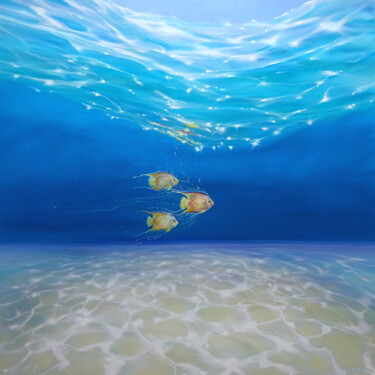The family in the history of art
The festive atmosphere, which distinguishes this special time of the year-end, brings with it the most authentic desire to share the joy of such moments with close friends and relatives. The history of art, although not making explicit reference to festive events in particular, has been able to immortalize, since ancient times and on various occasions, the most varied atmospheres of such family gatherings. In fact, this topic has been depicted in Egyptian, Greek, Roman, Medieval and Renaissance art, as well as in the historical period from the sixteenth to the twentieth century. To this last period belong the masterpieces of Bernard Strigel, Antoon van Dyck, Rembrandt van Rijn, Pietro Longhi, Francisco Goya, Jean-François Millet , Edgar Degas, Edouard Manet, Pierre-Auguste Renoir, Vincent van Gogh, Paul Gauguin, John Singer Sargent, Pablo Picasso, Egon Schiele, Giorgio De Chirico, Frida Kahlo, René Magritte and Salvator Dali.
 Akhenaten, Nefertiti and three of their daughters, 1340 BC. Limestone relief, 32 x 39 cm. Berlin: Altes Museum.
Akhenaten, Nefertiti and three of their daughters, 1340 BC. Limestone relief, 32 x 39 cm. Berlin: Altes Museum.
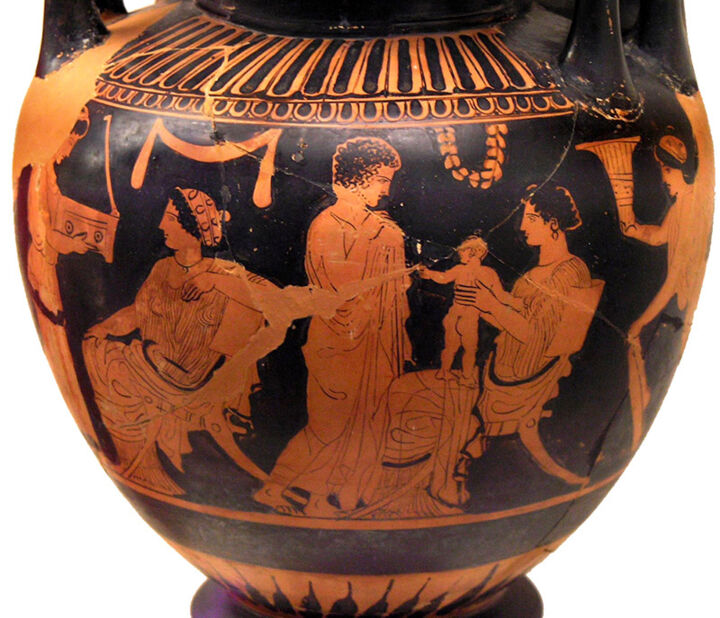 Family scene in a gynaecium,430 BC. Lebes gamikos with red figures, Athens: National Archaeological Museum.
Family scene in a gynaecium,430 BC. Lebes gamikos with red figures, Athens: National Archaeological Museum.
 Tombstone of a Roman soldier with family, 2nd-3rd century A.D. Enns: Museum Lariacum, Enns, Austria.
Tombstone of a Roman soldier with family, 2nd-3rd century A.D. Enns: Museum Lariacum, Enns, Austria.
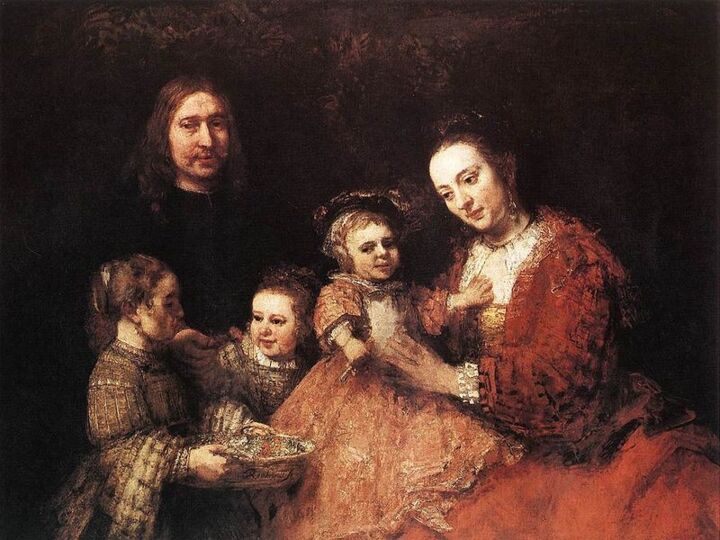 Rembrandt Harmenszoon Van Rijn, Family Portrait, 1668. Oil on canvas, 126 × 167 cm. Braunschweig: Herzog Anton Ulrich Museum.
Rembrandt Harmenszoon Van Rijn, Family Portrait, 1668. Oil on canvas, 126 × 167 cm. Braunschweig: Herzog Anton Ulrich Museum. Francisco Goya, The Family of Charles IV, 1800-1801. Oil on canvas, 280 x 336 cm. Madrid: Museo del Prado.
Francisco Goya, The Family of Charles IV, 1800-1801. Oil on canvas, 280 x 336 cm. Madrid: Museo del Prado.
 Edgar Degas, The Bellelli Family, 1858-1867. Oil on canvas, 200×250 cm: Paris: Musée d'Orsay.
Edgar Degas, The Bellelli Family, 1858-1867. Oil on canvas, 200×250 cm: Paris: Musée d'Orsay.
 Vincent Van Gogh, The Potato Eaters, 1885. Oil on canvas, 82 × 114 cm. Amsterdam: Van Gogh Museum.
Vincent Van Gogh, The Potato Eaters, 1885. Oil on canvas, 82 × 114 cm. Amsterdam: Van Gogh Museum.
Vincent Van Gogh: The Potato Eaters
The Potato Eaters, first important painting by Vincent Van Gogh to have been made in a distinctly expressionist style, depicts a modest family of Dutch peasants, who, gathered around a table, is characterized by rocky and coarse physiognomies, almost deformed and grotesque, designed to highlight the attitudes tired and hopeless of the protagonists of the canvas. In addition, the hands of the latter, gnarled and ungainly, were executed in the same style, with the intention of being a warning of the hard work of the countryside. In this regard, it is important to emphasize how the peasant life was a subject widely investigated by the Dutch master, so as to be portrayed in masterpieces of different periods. The Potato Eaters was made during the winter of 1884-1885, when Van Gogh went to Nuenen, a Dutch town at the time full of laborers, in order to devote himself to the study of rural life. In fact, in a letter dating back to those years, addressed to his brother Theo, the artist made clear his desire to immortalize the peasants who, intent on cultivating a dry land of fruits, were reduced to eating mostly potatoes. Van Gogh's masterpiece thus becomes an evocation of the hard and thankless manual labor of the laborers and, at the same time, also a testimony having the purpose of making the public sympathize with this social class.
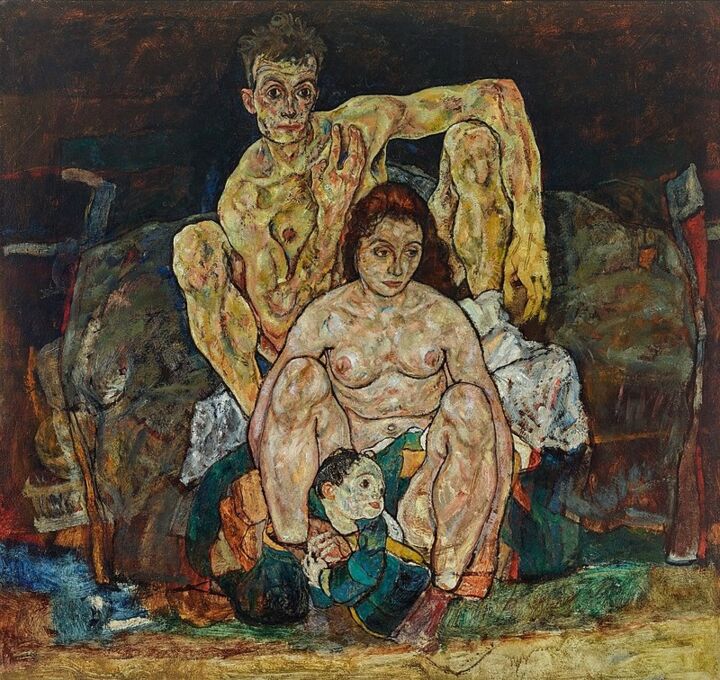
Egon Schiele, The Family, 1918. Oil on canvas, 152.5 × 162.5 cm. Vienna: Österreichische Galerie Belvedere.
Egon Schiele: The Family
Egon Schiele's The Family was painted in 1918, that is, shortly before the painter, his wife Edith and their son, portrayed in the work, were crushed forever by the Spanish flu. This painting is the fruit of the love between the artist and his wife-muse, whose union was the result of an impetuous love at first sight, which, in 1914, led Schiele to break off a previous relationship. The serenity brought by Edith's presence in the artist's life led him to move from works depicting tormented and suffering bodies to more intimate and composed themes. An example of this is The Family, a painting in which the artist's ideal of family is immortalized, but projected into the future. In fact, at the time of the creation of this masterpiece, Schiele's son was still in his mother's womb. Finally, it is important to emphasize how the work, despite the family theme, is able to convey the omen of the drama of the Spanish flu, transmitting a feeling of melancholy and suffering, given by the bodies restless, tired and full of emotional tension, the atmosphere of dark tones, the anatomies suffered and gazes lost in the void. In fact, only the artist looks at the viewer, as if he wanted to communicate to him all the weight of a destiny that is about to be fulfilled.
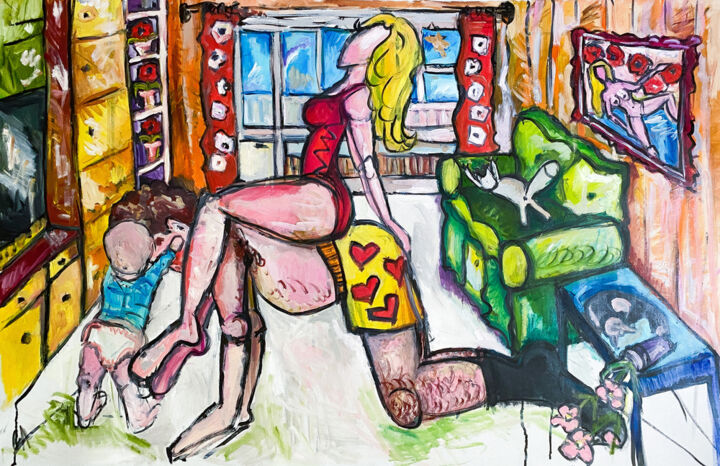 Sasha Neschastnova, Family, 2021. Oil and ink on linen canvas, 90 x 140 cm.
Sasha Neschastnova, Family, 2021. Oil and ink on linen canvas, 90 x 140 cm.
Sasha Neschastnova: Family
Like the great masterpieces of art history, the works of the artists of Artmajeur have also immortalized the family, such as, for example, the painting of Sasha Neschastnova, who, in the same way as Schiele's work, has portrayed mother, father and child, depicted, however, within a well-defined environment. Moreover, the highly original canvas of the artist from Artmajeur, unlike that of the Austrian master, has immortalized, through the use of vivid colors, a scene of serene, dynamic, cheerful, fun and carefree family life, where staticness and any kind of negative omen is absent. Finally, the work of Sasha Neschastnova, despite its great innovativeness, conferred by the poses, colors and unusual framing, re-proposes a popular theme within the history of art, such as the love relationship between mother, father and son, which has been the subject of both secular masterpieces, such as De Chirico's The Painter's Family and Picasso's The Family of Harlequin with Monkey, and sacred works of art, such as the Holy Families of Giorgione, Raphael and Rembrandt.
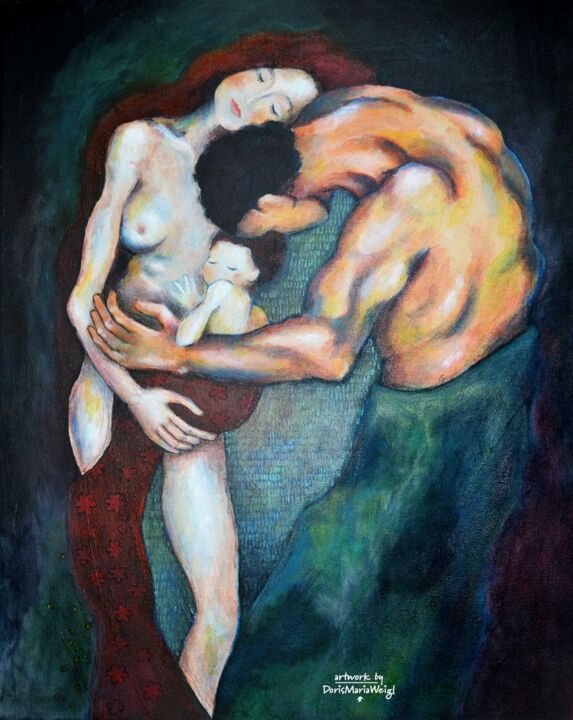 Doris Maria Weigl, Family, date unknown. Acrylic on canvas, 50 x 40 cm.
Doris Maria Weigl, Family, date unknown. Acrylic on canvas, 50 x 40 cm.
Doris Maria Weigl: Family
Another work having family love as its subject is the one created by Artmajuer artist Doris Maria Weigl, which seems to be a modern remake, albeit more bare, without colored decorations and bright background, of the Family painted by Gustave Klimt. The embrace depicted in the latter work, unlike the one executed by Weigl, is tighter, more involving, and intense, so that there are no empty spaces between the figures involved in the embrace. This gesture of affection has been the protagonist of other works made by the Austrian master, such as, for example, the Kiss, The Three Ages of Woman, and The Embrace, but also of other classics of art history, such as Botticelli's Flight into Egypt, Elisabeth-Louise Vigée Le Brun's Self-portrait with her daughter, Canova's Cupid and Psyche, Schiele's The Embrace and Koons' Bust Bourgeois. Therefore, the artist's original interpretation of Artmajeur's artist is located within the great Western artistic tradition.
 Vonny Indah, Cena con la famiglia della signora Shirley, 2016. Acrilico su tela, 90 x 140 cm.
Vonny Indah, Cena con la famiglia della signora Shirley, 2016. Acrilico su tela, 90 x 140 cm.
Vonny Indah: Dinner with Mrs. Shirley’s family
Artmajeur artist Indah's painting of a family gathered around a table addresses a widely exploited topic issue within the history of art. In fact, masterpieces of the past, such as, for example, Cornelis de Zeeuw's Portrait of the De Moucheron Family, Andries van Bochoven's Portrait of the Painter Andries van Bochoven and His Family by Andries van Bochoven, Jan Steen's The Happy Family and Frederick George Cotman's One of the Family, have depicted the same type of scene of everyday life. Nevertheless, the latter works, by immortalizing customs and habits that were widespread between the mid-sixteenth century and the end of the nineteenth century, are clearly different from the highly original painting of the artist from Artmajeur, which, set in our time, becomes an eternal documentary source of contemporary habits and lifestyle.


 Olimpia Gaia Martinelli
Olimpia Gaia Martinelli














